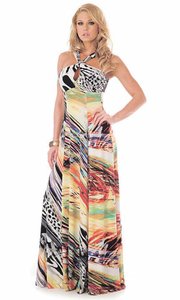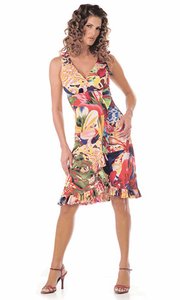No Free Samples
Designers and reps need to safeguard sample garments before they leave the warehouse.
Los Angeles designer Kambiz Hakimi’s Mesmerize label is known for its exotic prints over sexy silhouettes and delicate fabrics. When representatives from a well-known New York retail chain requested a sample garment, Hakimi obliged. That was the last he saw of the sample—until a knocked-off version appeared on the retailer’s e-tail Web site.
Such incidents are increasing in Los Angeles and other fashion capitals, Hakimi said. Considering a number of thefts that occurred during recent trade shows and the proliferation of private-label business, designers should take heed when it comes to managing samples, Hakimi warned.
Samples are often the only physical example of future collections clothing makers have. Missing samples can occur at the worst times, such as when Los Angeles label Rock & Republic had several samples stolen from its London rep’s showroom right when the company was launching its Victoria Beckham collection in 2006. So when they suddenly go missing, the success of a season could be in jeopardy. In some cases, it could be a case of clear-cut theft.
Los Angeles manufacturers’ rep Susan Burnett found that out on two occasions while showing at a recent apparel trade show. More than 250 samples of her premiere line, Luna Luz, went missing during the breakdown of the show. What shocked Burnett is that it happened again the next season.
“I was almost fired by the manufacturer,” she said. “The [samples] were not insured, and I had no idea what happened to them.”
Burnett said show organizers were unable to catch the thieves, and she was unimpressed by their response. She has since stopped exhibiting at that trade show.
Veteran insurance executive Robert Mahl, vice president of Santa Monica, Calif.–based Kessler Risk & Insurance Services, said reps and smaller companies usually don’t cover themselves for such losses. They can buy inexpensive business owners’ policies, but they usually don’t cover losses for goods in transit. He advises reps such as Burnett and others to buy a type of insurance called “Inland Marine” insurance or “Stock Thru Put” insurance.
“You have to make certain that a specific insurance policy also contains a property extension or endorsement for the goods at an appropriate limit for that exposure while it is at exhibition,” Mahl said. “Without insuring the goods in that specific manner, a manufacturer could be without coverage in a loss or, at best, in an ambiguous gray area where they’d have to fight with their insurance company for reimbursement. Of course, middle-market apparel manufacturers always have the advantage of their insurance broker’s claims department advocating on their behalf for a positive outcome.”
Mahl added that coverage for all of these situations can be secured with a worldwide transportation and storage policy, along with special endorsements to cover trade shows and exhibitions as well as salesmen’s samples coverage.New companies vulnerable
Protecting samples from theft or copying is something that industry consultant and author Kathleen Fasanella warns designers about, especially newer ones, whom she said are prime targets for some unscrupulous retailers.
“They know who’s green and who’s not,” she said. “They get a few samples from this designer and that one, and suddenly they have a whole store of free merchandise.”
In her book, “The Entrepreneur’s Guide to Sewn-Product Manufacturing,” Fasanella warns designers to never send out samples without receiving full payment up front.
“It doesn’t matter how polished you are or what fashion school you went to—it’s easy for some to tell if you’re new,” she said. “These smaller designers usually deal with small lots and are easy targets.”
Fasanella recounted another case in which one boutique owner would request samples from up-and-coming designers. But what the designers did not know was that the store owner’s best friend owned a large factory that knocked off the samples to be sold by the thousands at stores throughout the country at discounted prices.
One way to safeguard against such retailers is to visit Web sites such as RetailDish.com (www.retaildish.com) and Fasanella’s own Fashion-Incubator (www.fashion-incubator.com), both of which warn visitors of suspicious retailers.
In cases such as Hakimi’s, there is virtually no recourse, said Ilse Metchek, president of the California Fashion Association.
“There’s nothing you can do except to gain some professionalism,” she said. “See an accountant, an attorney and get professional advice.”
Frances Harder, executive director of Fashion Business Inc., deals with a lot of neophyte designers. She advises at least getting an invoice when sending out samples. “It’s more important that you know who you are working with,” she added.Legal remedies
Hakimi would like to see better enforcement over the issue. Fasanella said she has seen designers contact law enforcement to recover unreturned samples, and they had some success.
Some sales reps said Hakimi’s case is not unique. “Catalog retailers do it a lot,” said one veteran rep who requested anonymity.
Hakimi said some retailers will actually buy a small lot from his company, only to turn out a few thousand of the pieces in their offshore factories.
“You think you are going to get a big order,” he said. “In a way, they are covering their tracks, but we know what they are doing. But many times, I have only one sample.”
Hakimi said he is frustrated because many in the industry almost accept sample theft and copying as a part of the apparel business.
“Nobody is doing anything about it,” he said. “People get complacent.”
Attorney Staci J. Riordan of Los Angeles–based Fox Rothschild LLP said the situation may change for some designers if a proposed design piracy act passes, which was drafted to extend copyright protection to fashion designs. Currently, designers’ brand names can be protected by trademark, and original fabric, print or surface treatments can be copyrighted.
“If you designed the fabric or a screen print, or it was designed just for you, you can copyright it. Some embellishments are also copyrightable,” Riordan said. “Or you can try and register the garment for trade-dress protection like in the Trovata [v. Forever 21] case, except they did not register their garment.”
Riordan advises designers to photograph designs and keep duplicate sampleson hand if possible as well as maintain correspondences from retailers requesting samples. She also said designers should send a call tag or return postage with a letter asking the retailer to return the sample and stating that the sample is intended only for consideration of purchasing the style. Taking such measures can result in an “idea submission” case, a tort usually used in entertainment-industry applications.
“You may also have a breach of implied-in-fact-contract case,” she said. “At worst, you have clear documentation that may convince the retailer to negotiate a settlement with you to avoid a potential civil action.”
Robert Darwell and Elizabeth Berman of Los Angeles–based law firm Sheppard Mullin said there is also another outlet for designers—California’s unfair-competition statute.
“A person has standing to sue for unfair competition in California if he or she is eligible for restitution, meaning the defendant took money or property directly from the plaintiff,” explained Darwell. “A retailer who unfairly or fraudulently took the designer’s samples may be forced to return them under the unfair-competition law, but the designer may encounter legal challenges in seeking to disgorge the profits the retailer made from reproducing and selling the design.”
Both Sheppard Mullin and Fox Rothschild have divisions that specialize in trademark and intellectual-property rights for the apparel industry.
























